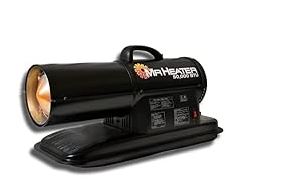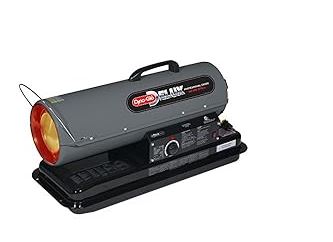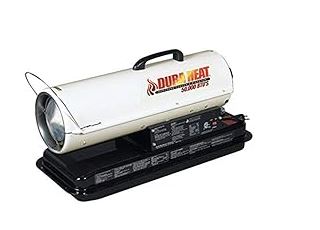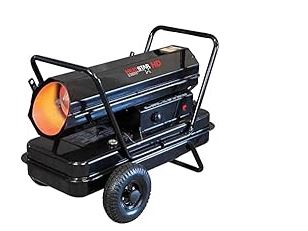| Note: This article may contain affiliate links, which means if you make a purchase following our links won’t cost you extra, but we may earn a commission. Learn more |
Selecting the best kerosene forced air heater involves considering various factors to ensure warmth, efficiency, and safety. Top kerosene heaters offer high BTU ratings for powerful performance, suitable for both indoor and commercial environments.
Users seek models that are not only portable but also boast features like integrated thermostats for better temperature control. The ideal heater combines longevity with low fuel consumption, ensuring cost-effectiveness.
Eco-friendly options are gaining popularity, minimizing environmental impact while providing reliable heat. For ease of use, models requiring minimal maintenance are preferred, especially for garage and industrial applications.
- Best Choice: Forced Air Kerosene Diesel Heater
Benefits of Kerosene Forced Air Heaters
Kerosene-forced air heaters stand out for their robust heating capabilities and cost-effectiveness. These heaters are known for their ability to quickly warm large spaces, making them ideal for workshops, garages, and construction sites where other heating solutions may fall short.
The fuel efficiency of kerosene as a heating source is a significant advantage, offering a higher energy content per gallon compared to other fuels. This translates to longer heating periods before refueling is necessary, which is especially beneficial in work environments or situations where constant heat is required over extended periods.
The portability of these heaters is another benefit, allowing users to move the heat source to different locations as needed easily. This mobility is coupled with the convenience of a readily available fuel source, as kerosene is commonly sold at many service stations.
With advancements in technology, many kerosene-forced air heaters now come with features such as built-in thermostats and safety shut-off systems, enhancing their functionality and user safety.
1. Mr. Heater F270255: Robust Warmth for Workspaces
Experience the powerful and reliable warmth of the Mr. Heater F270255, a forced-air kerosene heater designed to transform your workspace into a comfortable haven, regardless of the cold. With a substantial 50,000 BTU heat output, this heater efficiently covers up to 1,250 square feet, making it perfect for garages, barns, or tool sheds.
Its 4-gallon fuel tank promises up to 11 hours of consistent heat, ensuring your projects continue uninterrupted. The high-output fan distributes warmth evenly, while the illuminated on/off switch adds convenience and safety.
The auto shut-off safety sensors provide peace of mind, and the heater’s portability is enhanced with a carrying handle and cord storage. This CSA Certified heater is not just a heating solution but a commitment to a warm and productive work environment.
- Special Feature: High-output fan, Auto shut-off safety sensors
- Heat Output: 50,000 British Thermal Units
- Room Type: Garage, Barn, Tool Shed
- Dimensions: 32.5 x 14.25 x 14.5 inches
- Weight: 1 pound

Mr. Heater F270255: Robust Warmth for Workspaces
Key Features
- High BTU for large spaces
- Long-lasting fuel tank
- Safety auto shut-off
- Portable with cord storage
- CSA Certified
Compatible For
- Workshops
- Large outdoor tents
- Construction sites
Where Need to Improve
- Requires grounded 115-volt outlet
2. Dyna-Glo Delux KFA80DGD: Versatile Heating Powerhouse
The Dyna-Glo Delux KFA80DGD stands out as a versatile and potent forced-air heater, boasting an impressive 80,000 BTU output that can heat an area up to 1,900 square feet.
Ideal for both indoor and outdoor settings, this heater is a perfect ally for construction sites, industrial spaces, and commercial applications. Its Comfort Control Thermostat and exclusive run-time fuel gauge allow for precise control and fuel conservation.
The heater’s portability is a significant advantage, requiring minimal assembly and offering easy transportation with its sturdy construction and carrying handle.
The flameout sensor adds an extra layer of safety, making the Dyna-Glo Delux not just a heating device but a reliable source of comfort and efficiency.
- Special Feature: Comfort Control Thermostat, Run Time Fuel Gauge
- Heat Output: 80,000 British Thermal Units
- Room Type: Bedroom, Home Office, Study Room
- Dimensions: 32.01″D x 11.69″W x 16.69″H
- Weight: 26.9 pounds

Dyna-Glo Delux KFA80DGD: Versatile Heating Powerhouse
Key Features
- High BTU for extensive areas
- Thermostat for fuel efficiency
- Multi-fuel capability
- Easy to transport
- Minimal assembly required
Compatible For
- Industrial spaces
- Large indoor areas
- Outdoor construction
Where Need to Improve
- Primarily for indoor use
- Heavier than some competitors
3. Dura Heat DFA50: Compact Heating Dynamo
The Dura Heat DFA50 is a versatile and robust forced air heater that brings warmth to any space, be it a living room, bedroom, or home office. This gas-powered unit is multi-fuel capable, efficiently running on K-1 kerosene, #1 and #2 fuel oil and diesel, JP-8, and Jet-A fuels, offering flexibility in fuel choice.
With a 50,000 BTU heat output, it’s designed to meet the demands of temporary heating needs, light construction, and DIY projects. The one-touch electronic start and “runtime” fuel gauges provide convenience and ease of use, while the fuse-protected electrical system ensures safety and longevity.
The high-capacity sealed fan motor and heavy-duty ignitor are built to last, making the Dura Heat DFA50 a reliable source of heat.
- Special Feature: Multi-fuel capability, One-touch electronic start
- Heat Output: 50,000 British Thermal Units
- Room Type: Living Room, Bedroom, Home Office
- Dimensions: 13.3 x 31.9 x 16.7 inches
- Weight: 30.1 pounds

Dura Heat DFA50: Compact Heating Dynamo
Key Features
- Versatile fuel compatibility
- Easy electronic ignition
- Portable with a carrying handle
- High-efficiency fan motor
- Fuse protection for safety
Compatible For
- Light construction sites
- DIY project areas
- Various indoor spaces
Where Need to Improve
- Gas-powered may not suit all users
4. Heatstar by Enerco F170375: Industrial Grade Warmth
When the winter chill strikes, the Heatstar by Enerco F170375 comes to the rescue with its formidable 175,000 BTU per hour output, capable of heating an expansive area of up to 4,250 square feet.
This kerosene-powered heater is a powerhouse, perfect for outdoor use and large spaces that require significant heating. The adjustable temperature feature allows for precise control, ensuring comfort and efficiency.
The rolling cart form factor makes it easy to move the heater wherever needed, while the overheat safety shutdown feature adds a layer of protection.
Whether for commercial use or large-scale projects, this heater is designed to operate for approximately 10 hours on a full tank, providing consistent and reliable heat throughout the day.
- Special Feature: Adjustable Temperature, Rolling Cart
- Heat Output: 175,000 Degrees Fahrenheit
- Room Type: Outdoor, Large Indoor Spaces
- Dimensions: 42″D x 18″W x 22″H
- Weight: 1 Pound

Heatstar by Enerco F170375: Industrial Grade Warmth
Key Features
- Exceptional heating capacity
- Long operation on a full tank
- Overheat safety feature
- Easy to move with a rolling cart
- Durable construction
Compatible For
- Large workshops
- Outdoor events
- Commercial spaces
Where Need to Improve
- Not suitable for small indoor use
- Requires proper ventilation
How We Selected the Best Kerosene Forced Air Heater
Our selection process is meticulous, ensuring that you get the most efficient and reliable kerosene-forced air heater for your needs.
Market Research
We began by scouring the market for a range of heaters, identifying those that are consistently popular. We looked at various models, from portable units suitable for small spaces to robust commercial-grade heaters capable of warming large areas. We focused on products that promise high BTU output for maximum efficiency.
Customer Review Analysis
Real-world experiences provide invaluable insights. We delved into customer reviews to gauge satisfaction levels and performance in everyday use. This step helped us understand the longevity and operational costs associated with each model, as well as user experiences with the heater’s safety features and ease of maintenance.
Product Testing
We conducted hands-on tests to evaluate each heater’s performance. This included assessing the heat output, fuel consumption, and responsiveness of thermostats. We also tested the portability of each unit, considering the ease of moving the heater from one location to another.
Safety Standards
Safety is non-negotiable. We examined the built-in safety mechanisms of each heater, such as overheat protection and auto shut-off capabilities. We selected heaters that meet or exceed safety standards, ensuring they can be operated with peace of mind.
Eco-Friendliness
In our commitment to sustainability, we included eco-friendly heaters in our selection. These heaters are designed to minimize emissions and fuel waste, providing a greener heating solution.
Cost-Effectiveness
Value for money is key. We looked for heaters that offer a balance between upfront costs and long-term savings. This includes evaluating the initial price, fuel efficiency, and durability of the heaters to ensure they stand the test of time without frequent need for repairs or replacement.
Setting Up Your Kerosene Heater
The installation of a kerosene-forced air heater is a straightforward process that can be accomplished with minimal tools. Before beginning, it’s crucial to select an appropriate location for the heater. It should be placed on a stable, non-flammable surface with ample clearance from combustible materials. Ventilation is also key; ensure the space is well-ventilated to prevent the buildup of fumes.
Once the location is set, assembling the heater usually involves attaching the handle, assembling the fuel tank, and connecting the fuel lines, following the manufacturer’s instructions.
After assembly, filling the fuel tank with the correct type of kerosene is essential for proper operation. It’s recommended to use clean, water-free 1-K grade kerosene to prevent damage to the heater’s components. Before igniting the heater, check all connections for leaks and ensure the unit is stable.
The initial startup includes priming the pump, if necessary, and using the electronic or manual ignition system to light the heater. After the heater is lit, it’s important to monitor it for a few minutes to ensure it’s operating correctly and safely. Regular checks during operation will ensure the heater continues to function efficiently.
Maintaining Your Kerosene Heater
To ensure the longevity and safe operation of your kerosene-forced air heater, regular maintenance is essential. Start by adhering to a consistent cleaning schedule to prevent the buildup of soot and debris, which can affect the heater’s performance and pose a fire hazard. The wick, an integral part of the heater, should be checked frequently and replaced as needed to maintain efficient burning.
It’s also important to inspect the fuel tank periodically for any signs of rust or damage, as leaks can be dangerous. The air filters should be cleaned or replaced regularly to ensure proper airflow, which is critical for the combustion process.
For optimal performance, it’s recommended to have the heater serviced by a professional at least once a year. This typically includes a thorough cleaning of the internal components, a check of the electrical systems, and any necessary repairs.
Kerosene Heaters vs. Alternatives
In the realm of portable heating solutions, kerosene-forced air heaters are often compared to other types of heaters, such as propane, electric, or natural gas heaters. Each type of heater has its own set of characteristics that may make it more suitable for certain conditions and less so for others. Kerosene heaters are lauded for their high heat output and efficiency, especially in environments without access to electricity.
Unlike electric heaters, kerosene units do not rely on an external power source, which can be a significant advantage during power outages or in remote locations. Compared to propane heaters, kerosene heaters generally offer a longer burn time, reducing the frequency of refueling. Natural gas heaters require a fixed gas line, which limits their portability, whereas kerosene heaters can be easily moved to where heat is needed most.
The choice between these heaters often comes down to the specific needs of the user, such as the desired heat output, the availability of fuel sources, and the need for portability.
Kerosene heaters are particularly valued for their robust performance in outdoor and well-ventilated indoor spaces, making them a go-to choice for many seeking a reliable and portable heating solution.
Must-Have Accessories for Kerosene Heaters
Enhancing the performance and safety of kerosene forced air heaters is achievable with the right accessories. A well-chosen selection can extend the heater’s life, improve efficiency, and make the operation safer. Fuel cans designed specifically for kerosene prevent contamination and facilitate safe transport and storage of the fuel.
A siphon pump is another essential tool, ensuring clean and spill-free refueling of the heater. For those seeking to maintain a consistent temperature, a thermostat attachment can be invaluable, allowing for automatic temperature control and reducing fuel consumption.
Air filters are crucial for maintaining clean air output and efficient combustion, and having a few spares on hand ensures that replacements are available when needed. Carbon monoxide detectors are a non-negotiable accessory, providing an essential safety measure to alert users of dangerous fumes.
For ease of movement, a heater cart can be a practical addition, especially for heavier models, enabling users to move the heater between locations with minimal effort. And, a protective cover will shield the heater from dust and debris when not in use, keeping it in optimal condition for the next use.
Versatile Applications of Kerosene Heaters
Kerosene-forced air heaters are versatile in their applications, providing warmth in a variety of settings where traditional heating methods may not be feasible. In construction sites, these heaters offer the ability to work comfortably during the colder months, ensuring that projects stay on schedule. They are equally at home in workshops and garages, where they provide a quick heating solution without the need for complex installations.
Agricultural settings also benefit from these heaters, as they can be used to warm barns and protect livestock from the cold. For outdoor events, kerosene heaters can create a warm environment for guests in areas where electrical heaters are impractical.
In emergency situations, such as power outages during winter storms, these heaters become a critical source of heat. Their portability and high BTU output make them suitable for use in large spaces, and their fuel efficiency makes them a cost-effective option for extended use.
Safety Measures for Kerosene Heater Use
Operating kerosene forced air heaters safely is paramount to prevent accidents and ensure a healthy environment. It begins with using the correct fuel; only 1-K grade kerosene should be used to avoid the release of harmful emissions.
Storing kerosene in approved containers and away from living spaces minimizes the risk of accidental ignition or fume inhalation. It is also vital to operate the heater in well-ventilated areas to prevent the buildup of carbon monoxide.
Before each use, inspecting the heater for any signs of wear, leaks, or damage is essential. The heater should be placed on a stable, non-flammable surface and at a safe distance from any combustible materials.
Never leave the heater unattended, especially in the presence of children or pets, and always turn it off before leaving the area. Regular maintenance, including cleaning and replacing filters, ensures the heater operates efficiently and safely.
Some Important Relevant Queries
Optimal Placement for Kerosene Heaters
Where should a kerosene forced air heater be placed for maximum efficiency?
Position your kerosene forced air heater in a well-ventilated area to ensure proper air circulation and heat distribution. Ideally, place it on a flat, non-flammable surface, away from any combustible materials, ensuring it directs heat to the desired area without obstruction.
Fuel Types and Efficiency
Can different types of kerosene affect the heater’s efficiency?
Yes, the type of kerosene used can impact the heater’s efficiency. 1-K grade kerosene burns cleaner and more efficiently, while lower-grade fuels can produce more soot and odors, potentially clogging the heater’s mechanism and reducing its effectiveness.
Heater Sizing for Spaces
How do I choose the right size kerosene heater for my space?
To select the appropriate size, calculate the cubic footage of the space (length x width x height) and match it with the heater’s BTU output. A heater with a higher BTU rating can warm a larger area. Consult manufacturer guidelines for precise sizing.
Longevity of Kerosene Heaters
How long do kerosene forced air heaters typically last?
With proper maintenance, a high-quality kerosene forced air heater can last several years. Regular cleaning, correct storage, and using the right fuel type are critical factors that contribute to the longevity of the heater.
Safety Measures for Indoor Use
What safety measures should be taken when using a kerosene heater indoors?
Always ensure the room is well-ventilated to prevent carbon monoxide buildup. Use a carbon monoxide detector, never leave the heater unattended, and keep it away from flammable materials. Regularly inspect the heater for any signs of damage or leaks.
